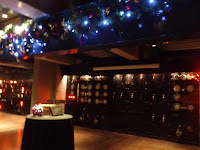As was probably clear in my round-up of royal residences, a big part of tourism in London relates to the monarchy. And the granddaddy of royal attractions is the Tower of London, built in the 11th century by William the Conqueror. Many people come to see the royal family jewels, but I prefer the history of buildings such as the Chapel of St. Peter ad Vincula (in chains), which served as the burial ground of famous traitors -- including Thomas Cromwell, Anne Boleyn, and Catherine Howard -- so the public couldn't turn their graves into martyr shrines. One notable exception is Sir Thomas More, who fought Henry VIII's subversion of the church so he could divorce; despite his private burial, More later became a saint because he chose death over relinquishing his faith.
The fortress was once a royal residence (top), with most accommodation in the White Tower (bottom left). I was lucky enough to visit the tower in the evening without big crowds (bottom right), so I could witness the tower's nightly version of the changing of the guard, the Ceremony of the Keys (then drink in the Yeoman Warders' pub). During another evening at the tower, I immersed myself in an interactive theatrical experience about surveillance called Nightwatchers.
The span across the Thames next to the tower is the Tower Bridge (left), although many people often confuse it with the much less architecturally spectacular London Bridge. Unlike the Tower Bridge, the London Bridge doesn't have a glass walkway above the road, and it isn't a drawbridge that rises on average twice a day (right). Sadly, the London Bridge now has obtained a distinct reputation due to a June 2017 terrorist attack.
The London Bridge once was the only thoroughfare connecting central London and Southwark. The bridge closed every night, creating a den of iniquity in Southwark as a base of "entertainment," including bear baiting, for overnighting tradesmen. Southwark has since shed its seedy reputation, gained mainly in the Elizabethan era hundreds of years after it was a base of religious royalty, including the bishops who lived at Winchester Palace (top left). Of course, the real seat of religious power in London is Westminster Abbey, which has hosted 16 royal weddings and numerous coronations since the 11th century (top right). St. Paul's Cathedral was active during medieval times, but it wasn't until the 17th century that Christopher Wren embarked on designing the current structure after the previous building was destroyed in the Great Fire of London in 1666 (bottom).
Even with its strong religious tradition, the United Kingdom maintains a mostly secular stance politically, mostly due to the Magna Carta, the rule-of-law document that was signed in 1215 at Runnymede (top left). Perhaps the most photographed symbol of the British government is Big Ben, which sits atop the Palace of Westminster, home of the UK houses of parliament (top right). A less recognizable but perhaps even more alluring government building is the Royal Courts of Justice (bottom left). Not surprisingly for the headquarters of an investigative agency, I suppose, one can only uncover Scotland Yard if he or she spies the blue plaque (bottom right).
Also unsurprisingly hidden are the Churchill War Rooms, the bunker underneath the present federal treasury and foreign-affairs building where the prime minister and his staff coordinated the country's World War II strategy. The main players would meet not in 10 Downing Street, which is just around the corner, but in the Map Room (left). Now that there's no current world conflict to address (knock on wood), the Radio Room can be rented for private events (right).














No comments:
Post a Comment